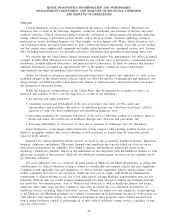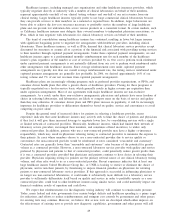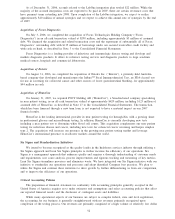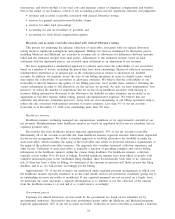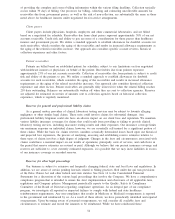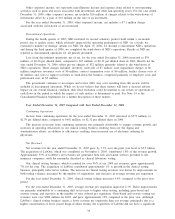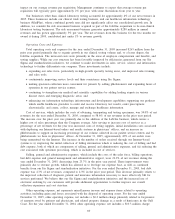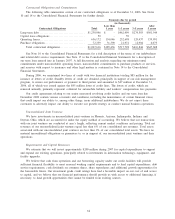Quest Diagnostics 2006 Annual Report Download - page 76
Download and view the complete annual report
Please find page 76 of the 2006 Quest Diagnostics annual report below. You can navigate through the pages in the report by either clicking on the pages listed below, or by using the keyword search tool below to find specific information within the annual report.overpayments and have taken corrective action where appropriate, we cannot assure investors that in each
instance the government will necessarily accept these actions as sufficient.
The process of analyzing, assessing and establishing reserve estimates relative to legal proceedings involves
a high degree of judgment. Changes in facts and circumstances related to such proceedings could lead to
significant revisions to reserve estimates for such matters and could have a material impact on our results of
operations and cash flows in the period that reserve estimates are revised or paid.
Management has established reserves for legal proceedings in accordance with generally accepted accounting
principles. Such reserves totaled less than $5 million as of December 31, 2006. Although management cannot
predict the outcome of such matters, management does not anticipate that the ultimate outcome of such matters
will have a material adverse effect on the Company’s financial condition but may be material to the Company’s
results of operations or cash flows in the period in which the impact of such matters is determined or paid.
However, we understand that there may be pending qui tam claims brought by former employees or other
“whistle blowers”, or other pending claims as to which we have not been provided with a copy of the complaint
and accordingly cannot determine the extent of any potential liability.
Accounting for and recoverability of goodwill
Goodwill is our single largest asset. We evaluate the recoverability and measure the potential impairment of
our goodwill under Statement of Financial Accounting Standards (“SFAS”) No. 142, “Goodwill and Other
Intangible Assets”. The annual impairment test is a two-step process that begins with the estimation of the fair
value of the reporting unit. The first step screens for potential impairment and the second step measures the
amount of the impairment, if any. Our estimate of fair value considers publicly available information regarding
the market capitalization of our Company, as well as (i) publicly available information regarding comparable
publicly-traded companies in the clinical laboratory testing industry, (ii) the financial projections and future
prospects of our business, including its growth opportunities and likely operational improvements, and (iii)
comparable sales prices, if available. As part of the first step to assess potential impairment, we compare our
estimate of fair value for the reporting unit to the book value of the reporting unit. If the book value is greater
than our estimate of fair value, we would then proceed to the second step to measure the impairment, if any. The
second step compares the implied fair value of goodwill with its carrying value. The implied fair value is
determined by allocating the fair value of the reporting unit to all of the assets and liabilities of that unit as if
the reporting unit had been acquired in a business combination and the fair value of the reporting unit was the
purchase price paid to acquire the reporting unit. The excess of the fair value of the reporting unit over the
amounts assigned to its assets and liabilities is the implied fair value of goodwill. If the carrying amount of the
reporting unit’s goodwill is greater than its implied fair value, an impairment loss will be recognized in the
amount of the excess. We believe our estimation methods are reasonable and reflect common valuation practices.
On a quarterly basis, we perform a review of our business to determine if events or changes in
circumstances have occurred which could have a material adverse effect on the fair value of the Company and its
goodwill. If such events or changes in circumstances were deemed to have occurred, we would perform an
impairment test of goodwill as of the end of the quarter, consistent with the annual impairment test performed at
the end of our fiscal year on December 31st, and record any noted impairment loss.
Accounting for stock-based compensation expense
Effective January 1, 2006, we adopted SFAS No. 123, revised 2004, “Share-Based Payment”,
(“SFAS 123R”) using the modified prospective approach and therefore have not restated results for prior periods.
Under this approach, awards that are granted, modified or settled after January 1, 2006 will be measured and
accounted for in accordance with SFAS 123R. Unvested awards that were granted prior to January 1, 2006 will
continue to be accounted for in accordance with SFAS No. 123, “Accounting for Stock-Based Compensation”
(“SFAS 123”), as amended by SFAS No. 148, “Accounting for Stock-Based Compensation – Transition and
Disclosure – an amendment of FASB Statement No. 123” (“SFAS 148”), except that compensation cost will be
recognized in our results of operations. Pursuant to the provisions of SFAS 123R, we record stock-based
compensation as a charge to earnings net of the estimated impact of forfeited awards. As such, we recognize
stock-based compensation cost only for those stock-based awards that are estimated to ultimately vest over their
requisite service period, based on the vesting provisions of the individual grants.
Prior to the adoption of SFAS 123R, the Company accounted for stock-based compensation using the
intrinsic value method prescribed in Accounting Principles Board Opinion No. 25, “Accounting for Stock Issued
to Employees” (“APB 25”), and related interpretations and chose to adopt the disclosure-only provisions of SFAS
55





